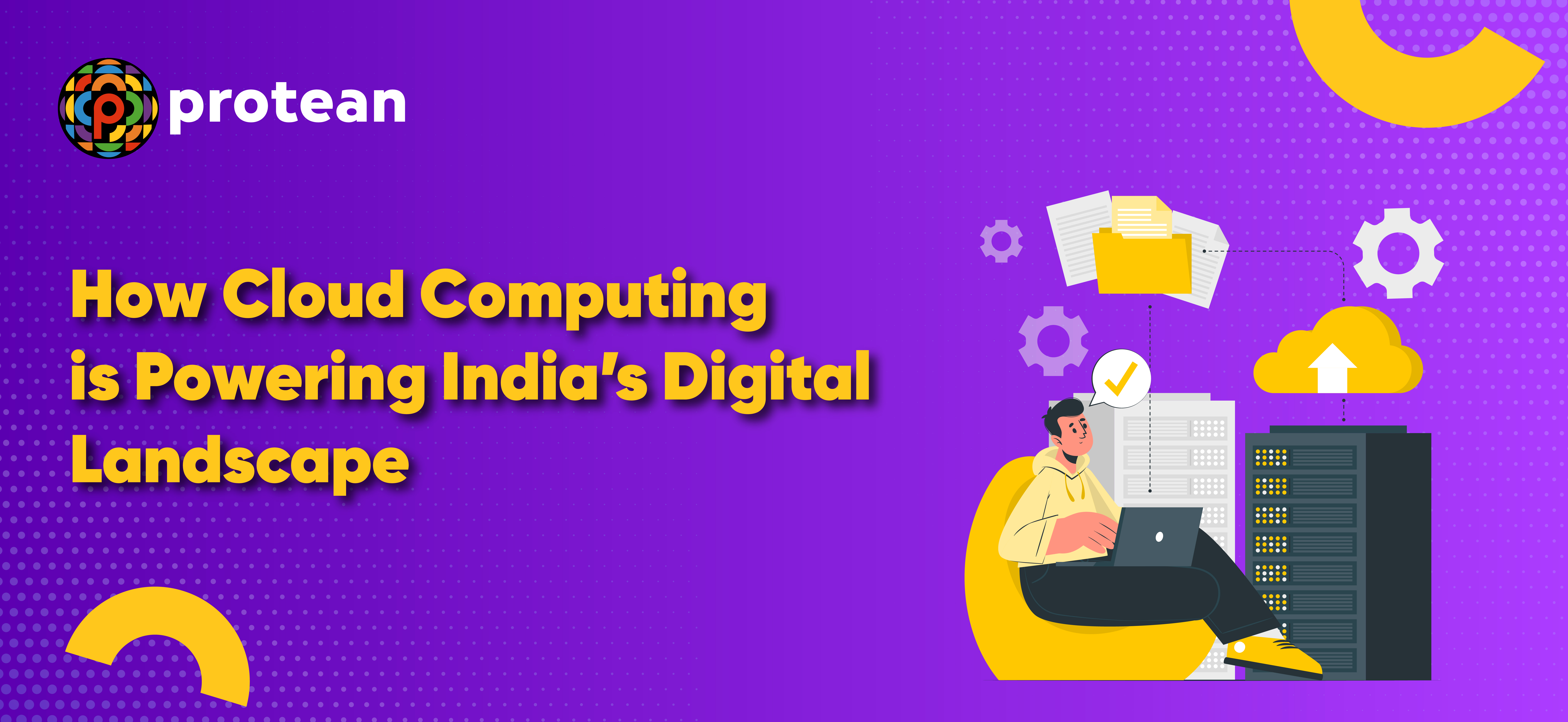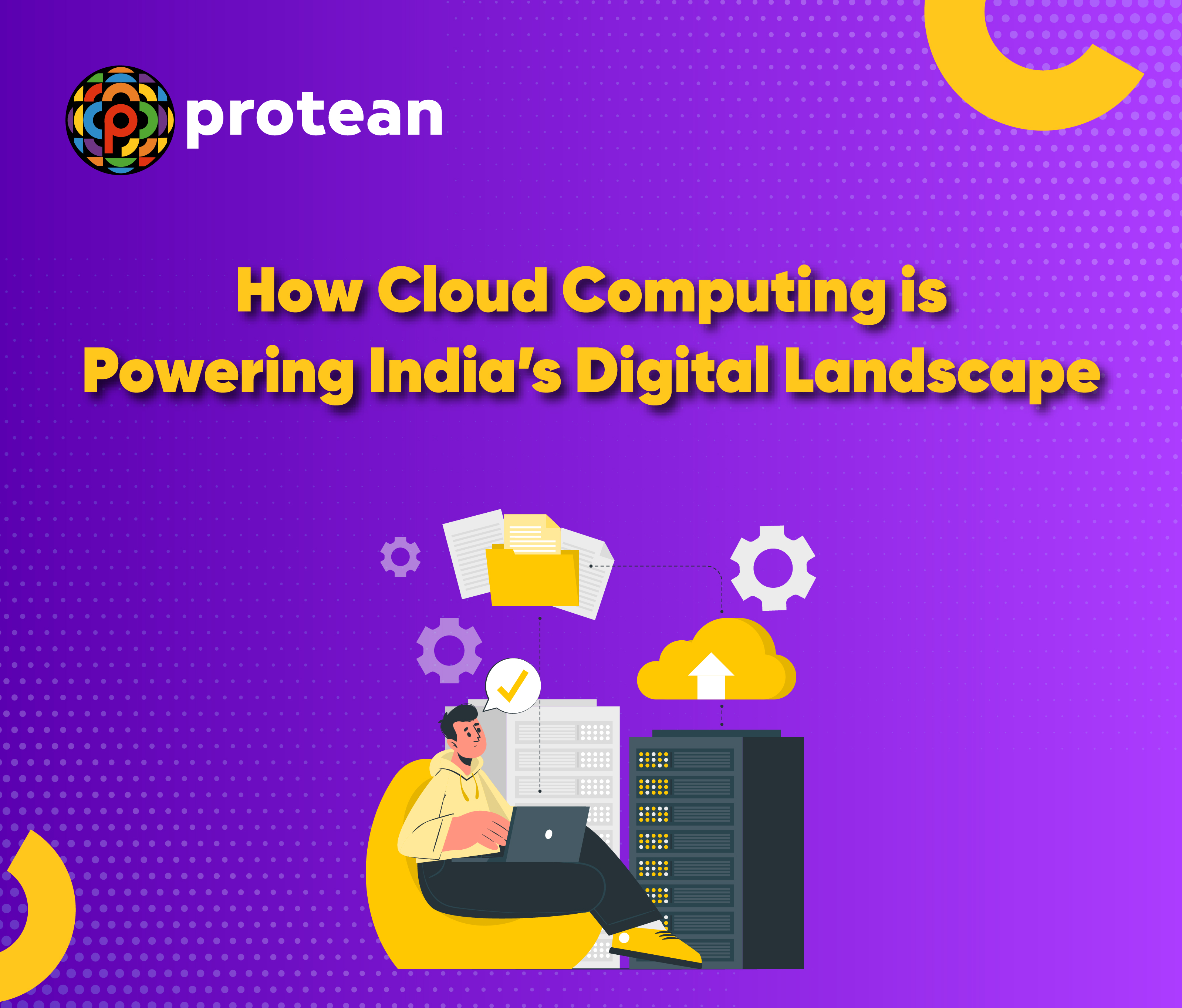India is emerging as the next big player in adopting cloud computing technologies for its business environment. With an expected CAGR of above 18.37%, the Indian cloud market is set to reach a value of around USD 17.80 billion by the year 2029.
This guide gives a brief idea about the cloud computing model, its types, benefits and, most importantly, how it is revolutionising India’s digital landscape.
What is Cloud Computing?
Cloud computing refers to the delivery of computing services like data storage, databases, servers, networks, software and more through the internet. It enables a user to save and work with files on a remote database rather than on hard drives or any local storage device.
A cloud technology platform performs the following operations:
- Data storage, backup, and data recovery.
- On-demand delivery of software.
- Creation of new applications and services.
- Streaming of audio and videos.
What are the Different Types of Cloud Computing?
There are five different cloud computing types based on the availability and accessibility of its services.
1. Private Cloud
Also known as a corporate cloud or internal cloud, a private cloud is created and managed by one organisation. This kind of cloud computing offers more control, customisation, and data security, similar to traditional IT setups. However, it also carries comparable costs and resource constraints in IT environments.
2. Public Cloud
Public Clouds are managed by third-party providers. This type of cloud computing is used to store and provide information, making it easily accessible to a wide range of users. Moreover, it uses the pay-as-you-go billing method to deliver the resources.
3. Hybrid Cloud
A hybrid cloud is a combination of two or more public clouds with a private cloud. It provides services to optimise an organisation’s performance and efficiency. In this cloud computing, the public cloud services are open to everyone, while private cloud services are exclusive to the organisation’s users. This setup combines the advantages of both public and private clouds for flexibility and scalability.
4. Multi-Cloud
Multi-cloud is used when companies use multiple service platforms to fulfil their computing requirements. It includes the distribution of work, applications, and data across various cloud setups—public, private, or hybrid. Businesses benefit from a multi-cloud approach as it helps to optimise service selection based on specific needs, minimise reliance on a single vendor, and leverage competitive pricing models from different providers.
5. Community Cloud
A community cloud allows a group of various organisations to access and share information. It is managed and owned either by the community’s organisations, a third party, or a mix of both. In this cloud computing setup, organisations from the same industry, government sector, or any community work together to create a shared cloud infrastructure. It enables them to share services, applications, and data tailored to their community’s needs.
What Are the Different Types of Cloud Computing Services?
The following is a list of different types of cloud computing services:
1. SaaS (Software as a Service)
SaaS is one of the most common cloud computing services. Users can access them through a web browser, a desktop client, or an API integrated with their desktop or mobile operating system. The key feature of SaaS is that the cloud service provider manages the software application and delivers it to users.
The provider takes care of software updates, bug fixes, and general maintenance, relieving users of these tasks. SaaS removes the need to install the application on each user's computer, allowing for convenient group or team access to the software.
2. IaaS (Infrastructure as a Service)
In IaaS, a cloud service provider handles the infrastructure on behalf of the user. It includes managing the actual servers, network, virtualisation, and data storage, all connected through the internet. A user gains access through an API or dashboard and effectively leases this infrastructure.
Moreover, users can allocate and manage these resources according to their needs, all on a pay-as-you-go basis. Additionally, this cloud computing service offers a flexible and scalable infrastructure without the need to manage physical hardware.
3. PaaS (Platform as a Service)
PaaS in the cloud computing model offers a third-party provider to deliver software and hardware tools to the user via the internet. It allows the users to run, develop, and manage applications without the burden of dealing with the cost, complexity, and rigidity of maintaining the platform on-site.
PaaS can deliver its services through private, public and hybrid cloud. Additionally, in a PaaS setup, the cloud provider takes care of servers, networks, storage, operating system software, middleware, and databases within their data centre.
4. DaaS (Desktop as a Service)
DaaS cloud computing service offers virtual desktops to end users via the Internet through a per-user subscription. The provider handles the backend management, making it easier for small businesses that find setting up their virtual desktop infrastructure too costly or resource-intensive.
DaaS includes maintenance, backups, updates, and data storage. Additionally, cloud computing service providers might manage desktop security and applications, or users can handle these aspects themselves.
5. Virtual Office
A virtual office is a cyberspace that involves cloud computing, networking and infrastructure. This type of cloud service allows organisations to set up remote offices and enables the employees to access the tool in the same way as one operates physically from a corporate office.
The usage of virtual offices ensures a company that the data is secured with the cloud-based server which stores the information. Furthermore, virtual offices are environment-friendly since they reduce the installation and usage of physical products.
6. NaaS
NaaS allows a user to rent networking services from cloud computing providers. It allows the user to operate their network without maintaining any networking infrastructure. This flexible technology platform enables a user or an organisation to keep pace with new innovations and rapidly changing business requirements.
It also optimises the user experience and network performance through its cloud-based subscription model. Moreover, NaaS helps a user in planning, distributing, and managing day-to-day network operations, including upgradation of software, monitoring and troubleshooting.
What Are the Benefits of Cloud Computing?
The following are some of the important benefits of cloud technology:
1. Cost-Effectiveness
Cloud computing helps to optimise IT costs by eliminating the need for significant capital expenses in buying and maintaining hardware and software. It operates on a pay-as-you-go model, ensuring that organisations or individuals only pay for the resources they use.
2. Speed and Flexibility
Cloud computing services are self-services and can be provisioned on demand, providing organisations access to computing resources. This flexibility enables quick scalability, allowing businesses to adapt to the sudden changing needs efficiently.
3. Enhanced Security Measures
Cloud providers offer a comprehensive set of security policies, technologies, and controls to strengthen overall security. It includes data encryption, access controls, regular updates, and compliance with industry standards
4. Global Scale and Elasticity
It enables businesses to scale resources and deliver the right amount of computing power and storage in real time. Furthermore, this scalability is vital for handling various workloads and ensures optimal performance globally.
5. Enhances Productivity
By eliminating the need for a hardware setup and ongoing management, cloud computing helps the IT teams from time-consuming tasks. It allows them to focus on more strategic initiatives, enhancing overall productivity within the organisation.
6. Improves Performance
Cloud provider services are kept in really safe and up-to-date data centres. These centres have the best computer equipment, making sure things run super fast and smoothly for the users.
7. Reliability and Redundancy
Cloud computing service platforms like Protean Cloud Computing facilitate robust data backup, disaster recovery, and business continuity. Data can be replicated across multiple redundant sites, enhancing reliability and ensuring uninterrupted services.
What Are the Different Applications of Cloud Computing?
Currently, India is adopting cloud computing to advance its e-governance initiatives throughout the country. It enables a user to integrate different cloud computing services such as IaaS, SaaS, DaaS, Virtual Office, Naas (Edge Cloud with 5G Private Network), and other Managed Services (like AI and automation).
The following are some of the different applications of cloud computing technology:
1. Storage and Recovery of Data
It allows users to store and back up their data securely in remote databases. Furthermore, losing data is one of the biggest concerns of a user; therefore, cloud service providers offer safe storage and backup for data and resources on the cloud.
2. Testing and Development
With cloud technology, businesses can use scalable and flexible cloud services for product development, testing, and deployment.
3. E-commerce Application
E-commerce applications in the cloud help users and e-businesses respond quickly to new opportunities. They use cloud environments to handle customer data, product data, and other operational systems, making things more efficient and quicker for business owners.
4. Big Data Analysis
Cloud computing plays a crucial role in analysing extensive data. Businesses can store and analyse huge volumes of data to gain important business insights because of the cloud’s unlimited storage capacity.
5. Educational Platforms
E-learning, online distance learning, and student information portals are some changes brought about by cloud technology in education.
6. Entertainment Applications Video Streaming and Entertainment
Various streaming platforms utilise cloud infrastructure to deliver high-quality video content to users, ensuring seamless and enjoyable viewing experiences.
7. E-governance Application
With the help of cloud computing, a user can avail the services of various government activities.
Takeaway
Cloud computing is popular among individuals, organisations and businesses because of its transformative abilities. It has proven to be crucial for the country’s development in the 21st century. Furthermore, cloud computing has transformed the digital landscape of India by providing scalability, accessibility, cost efficiency, and security to users.
Protean Cloud is a suite of AI-powered services that offers best in class managed features, live migrations, and performance dashboards, which empowers enterprises to reimagine business processes. Backed by over two decades of domain expertise, our versatile cloud ecosystem offers the flexibility to configure intelligent COMPUTE, Storage, Security, and business continuity solutions that ensure efficient, compliant, and uninterrupted business operations.


